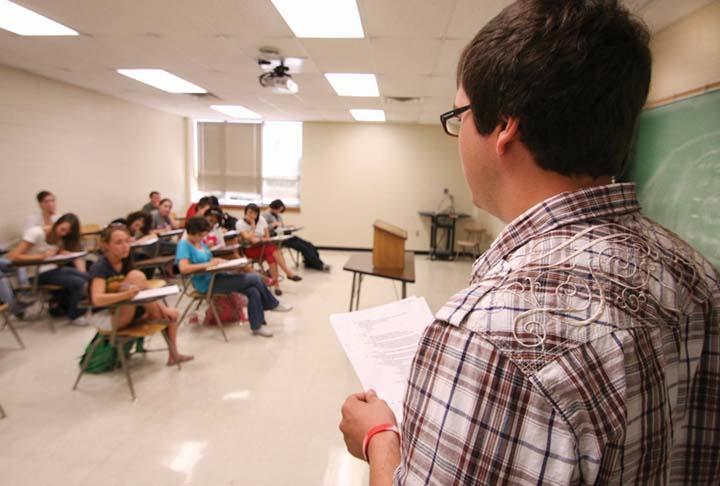RESTRUCTURING
Kaleb Hensley, freshman nursing major, delivers a speech during an oral communication class on Wednesday. As the class is restructured, students will no longer deliver speeches to live audiences. They will instead deliver speeches via computer programs to trained proctors.
The Communications 100 redesign began as a solitary effort, but the result will change the way many things run in the department.
After Missouri Gov. Jay Nixon put forth the Missouri Educational Initiative last November, colleges and universities across the state submitted their drafts of general education course redesigns. Missouri Southern chose to restructure its Comm. 100 course, a general requirement of all students graduating from Southern.
“Conferences happened in February and then again in April,” Kelly Larson, interim department head, said. “We submitted our proposal, we had to revise our proposal several times and then last Friday, [Sept. 21] there was a final up and down vote on the University proposals. Eleven colleges and universities in the state got an up and two got a reject.”
Next semester the redesigned Comm. 100 course will host its trial run, and Southern will share the course with other colleges and universities if it proves successful.
“It makes sense if you think about it from the viewpoint that we’re talking about general education courses,” Assistant Professor of Communications Shana Slavings said. “What we’re talking about here is throughout the state once a student has completed an entry level oral communication course, what expectations then should everyone have of that student.
“In some ways we are saying this is what we expect a student who completes a course to do once it’s done. The actual content of the day-to-day content is still up to the professor.”
Slavings and Larson are spearheading the course redesign and have taken into account the negatives, but they believe there are many advantages of redesigning. Larson said the school will save approximately $1,800 per adjunct not brought back and will increase the number of courses available to students.
“By restructuring the course, we no longer need as many adjunct instructors to teach the Comm. 100 course,” Slavings said. “It’s common knowledge as a general education course with Comm. 100 that every student that gets a degree at Missouri Southern will need to take that course or the equivalent of that course if they’re transferring in, so that’s thousands of students a semester, and with the small amount of faculty that we have in our department, in the past that required us to spend money on adjunct instructors.
“With the course redesign, we’re saving money not needing those adjunct instructors anymore, and it also gives the faculty more time to teach more upper level classes that meet their suited interest.”
Classes already being discussed include sports writing, community journalism, global journalism and cyber communication.
“I think that’s probably the most exciting byproduct in the department is, in the past, because we’ve had so many sections, the people that were full-time at the school would have taught two separate oral communication and two classes that were of their interest,” Larson said. “What it will do is it will allow us to offer a lot of classes that are in our catalogue that have already been through academic affairs that we just haven’t had the people available to teach.”
Other things being sacrificed for the positives are small class sizes, but this will come with forcing the University to meet the needs with today’s technology.
“In essence, what the course will look like in the fall is that there will be two sections that will meet for 75 minutes on Monday, another section will meet for 75 minutes on Tuesday,” Larson said.
“There will be essentially 235 students in those classes and they will be seated in Corely Auditorium. On Thursday and Friday, additionally, they are required to come to what’s called the communication arts assessment lab … where they will be required to do certain activities with Speech Class, which is the software our committee has chosen. They will upload speeches into those programs and those speeches will be graded by various people in the department and lab assistants.”
Larson said the developers of Speech Class have said they are willing to come to the class and show the classes how to use the program.
While some people do not think of a speech class as an online medium, Larson argues that technological advances have broadened the definition of an audience.
“I think in the past that perception may have been somebody standing at the front of the class or in front of a group of students, or a group of peers, or a business group or a corporate setting and give a speech to those people face to face,” he said.
Your donation will support the student journalists of Missouri Southern State University. Your contribution will allow us to purchase equipment and cover our annual website hosting costs.
















